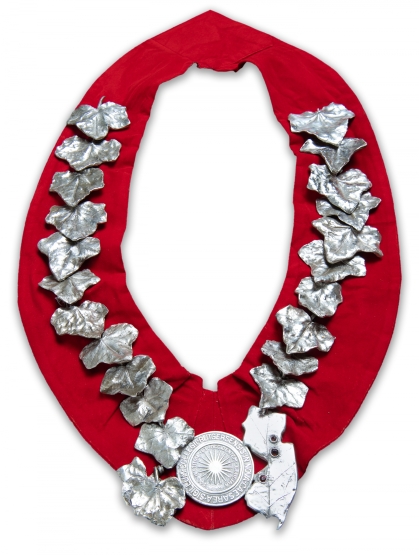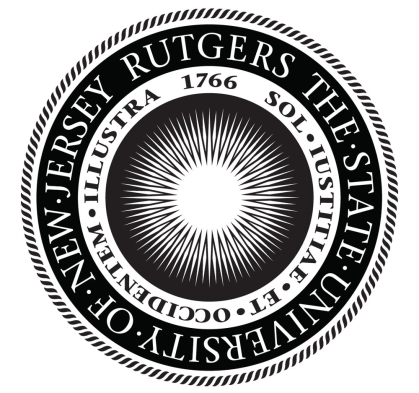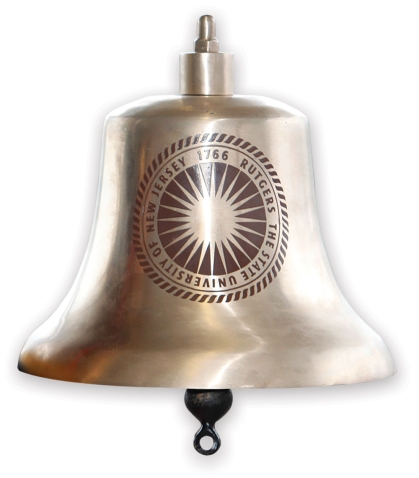Rutgers Traditions

The Presidential Medallion
The medallion bears the university seal and an outline of the state of New Jersey with three inset garnets marking Rutgers’ presence in New Brunswick, Newark, and Camden. Both the medallion and the chain are decorated with ivy and oak leaves. The ivy representing the university and oak leaves representing the state tree of New Jersey, the red oak.
The presidential medallion and chain were first presented at the inauguration of Francis L. Lawrence when he became Rutgers’ 18th president. Continuing with this inaugural tradition, Jonathan Scott Holloway was presented with the presidential medallion and chain on his official investiture as Rutgers’ 21st president on November 5, 2021.
The president’s chain, representing the chain of office, was designed and cast in sterling silver by Robert Cooke, professor at Rutgers’ Mason Gross School of the Arts, and Don Myhre, a 1991 graduate of the school. William Happel, a Vermont sculptor and then visiting artist at the school, assisted the pair.
The medallion and chain were commissioned by past chairs of the Boards of Governors and Trustees and made possible by their generous contributions.

University Seal
The university seal is the official imprimatur of Rutgers, The State University of New Jersey. As such, it appears on official documents, such as contracts and deeds, and, most notably, on the diplomas issued to graduates of the university.
The outer ring contains the name of the university. The inner ring includes the date of Rutgers’ founding, 1766, as Queen’s College, the eighth institution of higher learning established in the American colonies. The university’s motto, “Sun of righteousness, shine upon the West also,” appears in Latin in the inner ring, surrounding a stylized sunburst. The motto is an adaptation of the motto of Utrecht University, in the Netherlands, connoting the original college’s early affiliation with the Dutch Reformed Church. It is today interpreted as a request for the enlightenment of learning to shine equally upon the New World.

University Mace
The university mace, an ornamental staff symbolizing the authority of the president, is borne before the president in academic processions by the secretary of the university.
The design of the Rutgers mace incorporates signs of the institution’s traditions and status as New Jersey’s state university. The head of the mace bears the university’s coat of arms and its seal worked in colored enamel and gold on silver, all surmounted by a facsimile of the crown of Queen Charlotte, for whom the university was originally named “Queen’s.” The long shaft is made of stained wood and silver on which are engraved intertwining ivy leaves, symbolizing learning; red oak leaves, representing New Jersey’s state tree; and violets, the state flower.
The mace was a gift to the university from the Raritan Valley Chapter of the Society for the Advancement of Management and the New Brunswick-Raritan Valley Chamber of Commerce, in recognition of Rutgers’ bicentennial commemoration in 1966. The mace was designed by J. Russell Price, director of design for the Gorham Manufacturing Company, and crafted by the Gorham silversmithing department.

Red Lion Bell
Students who process in Rutgers University–New Brunswick and Rutgers Biomedical and Health Sciences Commencement may ring the Red Lion Bell to signal their arrival.
The name “Red Lion” harks back to 1771, when a handful of students attended the first classes of Queen’s College in a converted tavern, called the Sign of the Red Lion, located at the corner of Albany and Neilson streets in New Brunswick. The bell itself is part of a Rutgers graduation tradition. In 1825, Colonel Henry Rutgers donated the interest on a $5,000 bond and a bell to the then struggling Queen’s College. The money kept the college alive and as a token of its gratitude, Queen’s College was renamed Rutgers College. With a beautiful new bell in place, every graduating member of Rutgers College would ring “The Old Queens Bell” as a rite of passage before graduation.
Today it is not possible to ring the actual 1825 bell. However, to keep the tradition alive, an alumnus, who wishes to stay anonymous, donated this smaller bell to the Rutgers University Historical Society. During New Student Convocation held at the start of the academic year, incoming students ring the bell to mark the beginning of their studies. At Rutgers University–New Brunswick and Rutgers Health Commencement, the bell is stationed at SHI Stadium, where graduating students may ring it to signify their graduation, continuing a beloved Rutgers tradition in a new way.